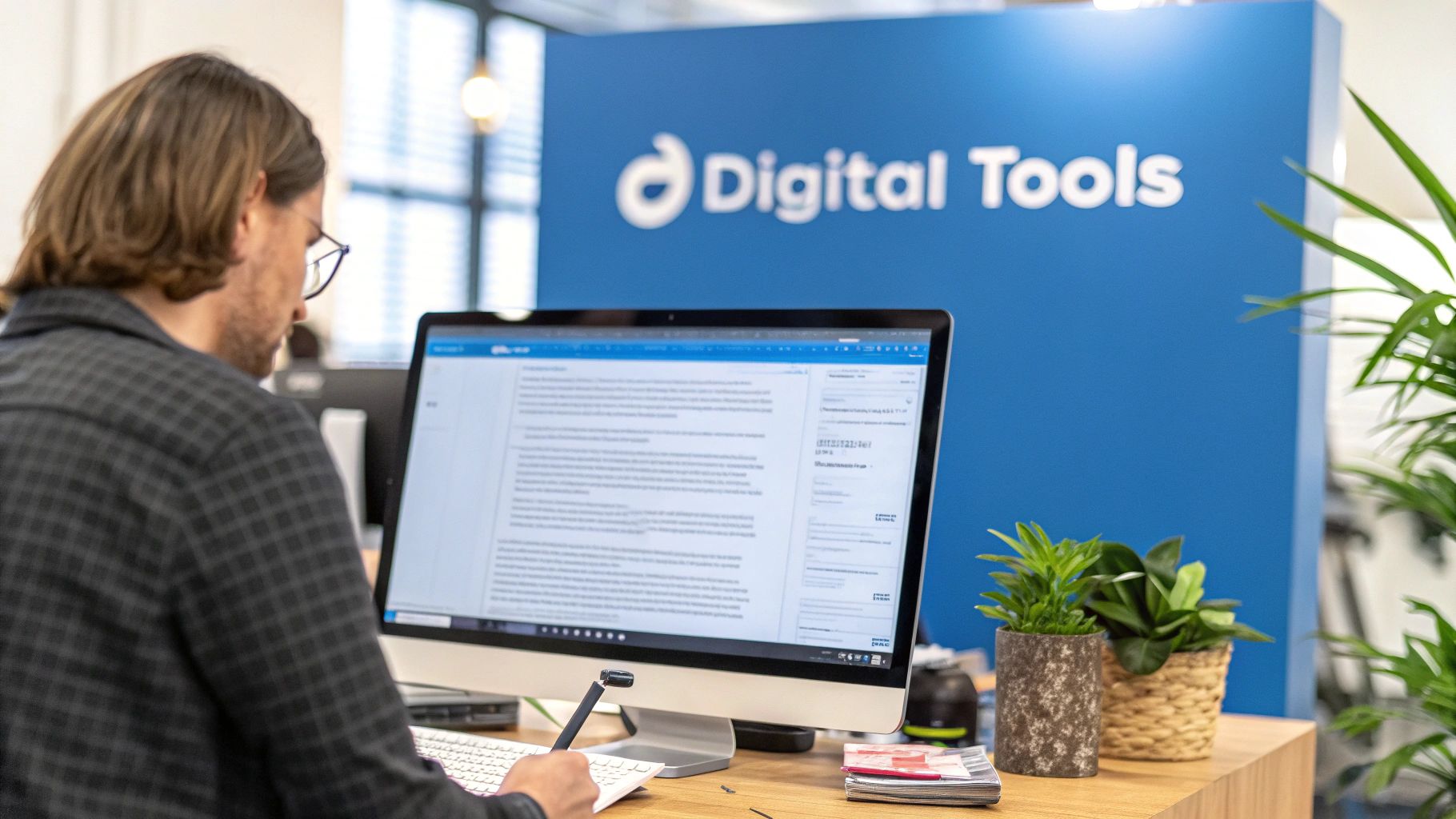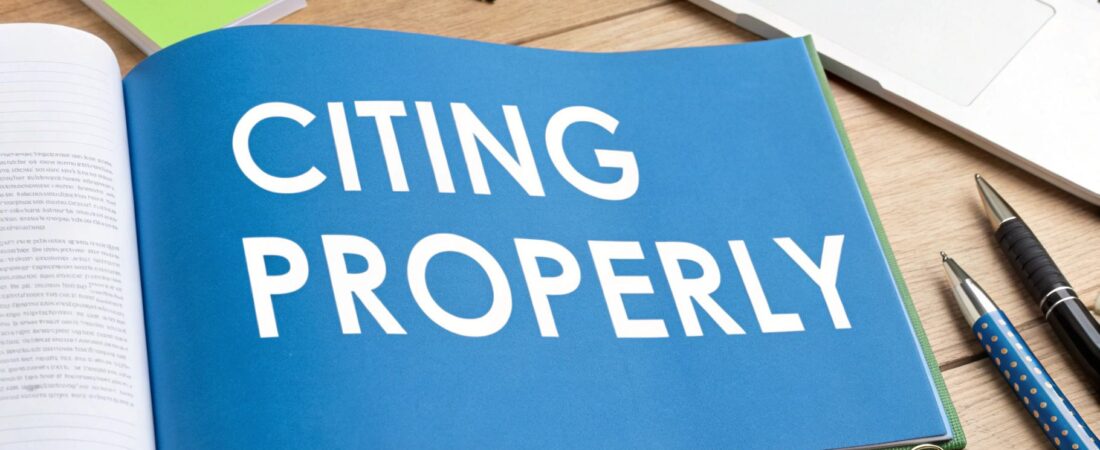Breaking Down the Citation Challenge

Citing sources correctly forms the backbone of academic writing and quality research. When you cite properly, you do more than just avoid plagiarism – you join an ongoing scholarly conversation and build on existing knowledge. Let's break down the key aspects of citation to help you master this essential academic skill.
Why Proper Citation Matters
Think of citation like giving credit to architects and builders who construct a house – your academic work similarly builds on the foundations laid by other researchers. When you cite sources accurately, you show respect for others' intellectual work while strengthening your own credibility. Clear citations help readers verify your sources and trace the development of ideas, creating a chain of trust in academic discourse.
Developing a Citation Workflow
Creating an organized system for managing citations from the start helps prevent last-minute scrambling and mistakes. Many scholars find success by maintaining a working bibliography as they research. This provides a central place to track all citation details.
- Start Early: Record citation information the first time you use a source.
- Stay Organized: Use tools like spreadsheets, reference managers, or note cards to track key details including authors, titles, dates, and links.
- Be Consistent: Pick one citation style (MLA, APA, Chicago, etc.) and use it throughout your work to maintain uniformity.
Understanding Core Citation Elements
While different citation styles have specific requirements, most share common basic elements. Knowing these core components helps you gather the right information from any source.
| Element | Description |
|---|---|
| Author(s) | The person(s) or group who created the source |
| Title | The name of the work you're citing |
| Publication Date | When the source was published |
| Source Location | Where the source can be found (journal, website, etc.) |
For a journal article, you need the author's name, article title, journal name, volume/issue numbers, publication date, and page numbers. Website citations require the author (if given), page title, site name, date, and URL. Each source type has specific elements that help readers find and verify the original material.
These fundamental steps, combined with understanding citation's purpose, give you the tools to handle citations confidently and contribute meaningfully to academic discourse. The next section explores specific citation formats with detailed examples and expert guidance.
Mastering Essential Citation Styles
Understanding proper source citation is key for strong academic writing. Let's explore the major citation styles – APA, MLA, and Chicago – and learn how to use each one effectively in your work. Each style has distinct conventions that serve different academic disciplines.
Navigating the Nuances of APA, MLA, and Chicago
Your field of study typically determines which citation style to use. Social sciences like psychology and education rely on APA (American Psychological Association) style. MLA (Modern Language Association) style is standard in humanities fields such as literature and philosophy. History and art history scholars often prefer Chicago style, which offers both notes-and-bibliography and author-date formats.
Each style reflects different priorities in how information is presented. APA emphasizes when research was published by prominently featuring the year in citations. MLA focuses more on locating specific content by requiring page numbers. Chicago, especially in its notes format, provides space for detailed source information and commentary through footnotes or endnotes.
Practical Examples of Citation Styles
Let's look at how these styles differ using a simple example of citing a book called "The Art of Research" by Jane Doe from 2023:
- APA: (Doe, 2023)
- MLA: (Doe 123) – when citing page 123
- Chicago (Notes & Bibliography): 1. Jane Doe, The Art of Research (New York: Example Press, 2023), 123.
These small differences matter. APA's year-first format helps readers assess how current the research is. MLA's page numbers make finding quoted passages simple. Chicago's detailed notes allow for thorough documentation and analysis.
Overcoming Formatting Challenges and Maintaining Consistency
Consistency in citations strengthens your work's credibility. Citation management tools can help organize and format references correctly. You might find this helpful: How to master citations using our generator. While these tools are useful, always review generated citations for accuracy.
Citing non-traditional sources like social media or interviews can be tricky. Though style guides provide direction, you may need to adapt standard formats. Focus on including enough details for readers to find the original source, even if it doesn't perfectly match typical citation patterns.
Learning citation styles is an ongoing process that gets easier with practice. As you become more familiar with each style's requirements, you'll cite sources with greater confidence and accuracy. Careful attention to citation details not only validates your research but also connects your work to broader academic conversations. Think of citations as building blocks – when properly placed, they create a solid foundation for scholarly work.
Using Digital Tools Without Getting Overwhelmed
Working with different citation styles like APA, MLA, and Chicago requires smart use of digital tools. While these tools make citing sources much easier, it's important to use them thoughtfully. The key is balancing technology's convenience with your own understanding of proper citation practices.
Finding Your Ideal Citation Tool
There are several great options for managing citations, including Zotero, Mendeley, and EndNote. Each offers helpful features like automatic citation creation, cloud syncing, and word processor plugins. When choosing a tool, consider your specific needs and workflow. For instance, Zotero works well for organizing PDFs and creating bibliographies, while Mendeley shines when collaborating on group projects. The best tool is simply the one you'll actually use regularly because it feels natural to you.
Double-Checking Computer-Generated Citations
Digital tools can create citations quickly, but they aren't perfect. Issues like data entry mistakes, software bugs, and inconsistent online source information can lead to citation errors. This means you should always review computer-generated citations carefully. Check each element – author names, titles, dates, and publication details – against the original source. Think of citation tools as helpful assistants rather than replacements for your own careful review.
Handling Modern Sources: From Social Media to Databases
Online content creates new citation challenges. When citing tweets, YouTube videos, or database entries, you may wonder about the right format. While style guides don't always have clear rules for every digital source, the basic goal remains the same: give readers enough details to find the source themselves. For social media, include the username, post content, platform name, timestamp, and URL. With databases, note the database name, ID numbers, and version information. These small details matter – they show thorough research practices and maintain academic integrity. The key to good citations in the digital age is understanding both what your tools can do and where they need your help. By combining digital convenience with careful human review, you can create accurate citations while avoiding complete dependence on automation.
Avoiding Citation Nightmares

Even experienced researchers know how challenging proper citation can be. Small mistakes in citing sources can seriously damage your academic credibility and raise questions about plagiarism. Let's explore how to avoid common citation problems and maintain accuracy in your work.
Identifying Common Citation Errors
The most frequent citation mistakes often stem from simple oversights that can have major consequences. For instance, mixing up publication dates or forgetting page numbers makes it difficult for others to find your sources. Using different citation styles within one paper creates unnecessary confusion. Perhaps most seriously, failing to use quotation marks around direct quotes – even when you include a citation – can lead to accusations of plagiarism. These details matter immensely for establishing your work's reliability.
Fixing Citation Mistakes: A Step-by-Step Guide
When you spot a citation error, take immediate action to fix it. Begin by comparing each element of the citation against the original source. Look carefully at author names, titles, dates, and publication details. While time-consuming, this verification process is essential. For example, if you notice a date seems wrong, go back to the source document rather than relying on your notes. When citations make sources hard to locate, use academic databases and search engines to track down the correct information. Remember that precision in citations supports the integrity of your research.
Strategies for Maintaining Accuracy in Long Documents
Keeping citations accurate throughout extensive documents requires organization and method. Many researchers find success using citation management software to track and format their sources. As you conduct research, build a working bibliography to record potential sources – this preparation saves considerable time later. For bigger projects, try reviewing citations section by section rather than all at once. This focused approach helps catch errors before they spread throughout your work. You might be interested in: How to master citations with our checker.
Ensuring Consistency Across Collaborative Projects
When multiple authors work together, maintaining consistent citations becomes more complex. Start by agreeing on a specific citation style and making sure everyone understands the requirements. Schedule regular citation reviews among team members to catch any inconsistencies early. Consider using shared citation management tools to create a central source database that all team members can access. This shared approach promotes uniformity and reduces errors. Success in collaborative work depends on clear communication and shared responsibility for citation accuracy.
Tackling Complex Source Challenges

Researchers frequently encounter sources that don't fit neatly into standard citation formats. From rare historical documents to digital media content, these materials require careful attention to provide complete and accurate citations. Making sense of complex sources means adapting conventional citation rules while ensuring others can locate and verify the information.
Citing Archival Materials and Historical Documents
Working with archival materials requires attention to specific details that help others locate these unique items. When citing a historical letter, include key information like the author, recipient, date written, archive name, and physical location. For proper source identification, also note the collection name and any reference numbers assigned to the document. These precise details enable other scholars to find and examine the same materials in their research.
Navigating Personal Communications and Interviews
Emails, letters, and interview transcripts present unique citation challenges since they aren't publicly available. Standard practice is to cite these only in the text rather than the reference list. For example, reference an email as (J. Smith, personal communication, October 26, 2024). This provides context without creating a formal bibliography entry. Remember to get permission before citing any personal exchanges.
Referencing Multimedia: Images, Audio, and Video
Digital content needs specialized citation approaches. For a YouTube video, include the creator's username, video title, upload date, and URL. Image citations should contain the artist's name, title, creation date, and source location, such as a museum database. These specifics help readers find and verify visual and audio materials that support your work. Learn more in our article about how to master citations using other tools.
Handling Translated Works and Multiple Authors
Citing translated materials requires crediting both the original author and translator. Add "translated by [Translator's Name]" after the title in your citation. For works with multiple authors, follow your citation style's specific rules – some use "et al." for long author lists while others require listing all contributors. Being consistent with these guidelines ensures proper credit for everyone involved.
Addressing Missing Publication Information
Sometimes key details like publication dates or publisher names are unavailable. In these cases, use standard abbreviations like "n.d." (no date) or "n.p." (no publisher) to show the information is missing. For instance, cite a book without a publication date as (Doe, n.d.). This honest approach maintains academic integrity while acknowledging gaps in source information. Clear documentation of these details, even when incomplete, strengthens the quality and reliability of your work.
"Building Your Academic Reputation" section in a more natural style:
Building Your Academic Reputation
When you cite sources properly, you do more than just avoid plagiarism – you actively join important academic conversations and establish your scholarly identity. Good citation practices show that you respect and build upon others' work while strengthening your own arguments. The way you handle citations directly shapes how other scholars view and engage with your research.
Why Accurate Attribution Matters
Think of academic work like constructing a building – you need to acknowledge the architects and builders who created the foundation before you. When you cite sources accurately and consistently, readers can follow how ideas developed over time, creating clear connections between past and present scholarship. This transparency helps build trust with other researchers and makes them more likely to seriously consider your contributions.
The Power of Citations in Scholarly Discourse
Citations create important bridges between your work and the broader academic community. When you thoughtfully cite foundational papers in your field, you demonstrate that you understand its history and can place your research within that context. This helps others grasp why your work matters and how it advances knowledge in meaningful ways.
Engaging With Your Field Through Thoughtful Citation
Effective citation goes beyond just listing references – it means truly engaging with the ideas you're citing. This involves carefully analyzing other scholars' arguments, discussing their strengths and limitations, and showing how your work builds on or challenges existing perspectives. When you engage deeply with sources this way, citations become valuable tools for scholarly dialogue rather than mere technical requirements. Plus, making your sources easy to find and verify encourages other researchers to cite your work, expanding your academic influence.
Ethical Considerations and Building Trust
Following high ethical standards in citation is essential for developing a strong scholarly reputation. When you represent others' work accurately, you help create an academic culture based on respect and integrity. While citation metrics like h-index scores can indicate research impact, focus first on quality attribution practices rather than chasing numbers. By maintaining solid citation principles throughout your career, you establish yourself as a credible and valued contributor to your field.
Ready to take control of your citations and boost your academic reputation? SmartStudi offers powerful AI-powered tools designed to streamline your research and writing process. From citation generators to plagiarism checkers and essay assistance, SmartStudi provides the support you need to succeed. Visit https://smartstudi.com today and discover how SmartStudi can help you achieve your academic goals!
